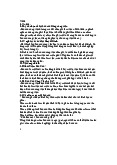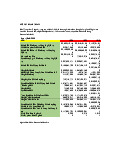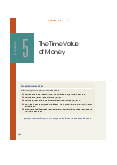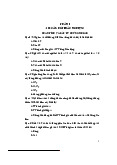














Preview text:
ạ ọ ữ Văn hóa ậ ố
CONTEXTUAL FACTORS THAT IMPACT ON TEACHER’S BELIEFS
teachers’ narratives displaying beliefs of 9 Mexican teachers working in a state in Central
the identification of concrete factors that in Teachers’
beliefs, which frame the contextual factors and guide the teachers’ pedagogical decisions.
eacher’s beliefs, language learning strategies, c
to understand Teachers’ Beliefs as part of the process of teachers’ development. The learning
Despite the fact that Teachers’ Beliefs have been studied from different angles, the research ạ ọ
ữ và Văn hóa ậ ố
the beliefs of the learning process, Teachers’ Beliefs
se of teaching and learning, “ students LLS”
students’ use of LLS or their own beliefs about these strategies, the teaching practice cannot be
Teachers’ Beliefs in the teaching of languages are particular, changeable, subjective, and
‘beliefs are individually held conceptions that are in constant relation to the context and teachers’ experience’.
in Teachers’ Beliefs in guiding teaching choices is importance beliefs (Gay, 2014). Nevertheless,
English teachers in Mexico provided the context to explore Teachers’ Beliefs on the
teachers’ beliefs. The second describes the methodology that was followed. T ạ ọ ữ Văn hóa ậ ố
Many researchers have scrutinised Teachers’ Beliefs from different angles as well as the í
the imperative need to further the understanding of Teachers’ Beliefs (Fives
research Teachers’ Beliefs was a threefold purpose choice (for an updated review on LLS see
Oxford, 2018). First of all, despite the large available body of literature in the area of Teachers’ ạ ọ
ữ và Văn hóa ậ ố
of Teachers’ Beliefs. Furthermore, it is worth emphasising that the use of LLS as the lens to
explore Teachers’ Beliefs allowed to propose an instrument that, using t
identify their ‘favourite strategy or strategies and the way they manage the learning process’ so
path, researchers started looking at the characteristics embodied by a ‘good learner’ (Rubin, 1975;
‘the good language learner is a willing and accurate guesser, has a strong dri
own and the speech of others, and attends to meaning’. These characteristics were the bases of
exemplifies the process by presenting excerpts from 9 teachers’ narratives.
strategies they may have never used in their classes, which allowed access to Teachers’ Beliefs ạ ọ ữ Văn hóa ậ ố
to explore the underlying factors by which teachers’ use and fostering of LLS may be hindered.
All the teachers’ narratives were transcribed verbatim, a qualitative
conducted to explore the underlying factors by which teachers’ use and fostering of LLS may be
hindered. Oxford (2016:315) explains that ‘strategy assessment and research might begin to rely
from 8 teachers’ narratives because these selected teachers cover all teaching levels and are
In this section, a sample of some strategies found in the teachers’ narrative
following excerpts, they show samples of strategies found in the teachers’ narratives where ạ ọ
ữ và Văn hóa ậ ố
fostering of LLS by creating Teachers’ Beliefs that these strategies are not possible to use in their
about students’ capabilities; b) Beliefs about external constraints; and, c) Beliefs about socio
Beliefs about the students’ capacities
[the students] come to tell you “what do do”? … like …
assessed about what they do or don’t do when they study […]. […] … … …
[…] that saying “yes
contributing?” because
instrument in her class, the fact that Heidy uses the expression ‘
’ points to a belief that she holds that her students may not have the ethics Heidy considers
knowledge or skills, and this belief can be seen in Alejandra’s narrative. Alejandra is a teacher ạ ọ ữ Văn hóa ậ ố
ning, Alejandra’s opinion reflected a different belief:
(…) tolerance to failure. (…)
select who participates (…) but all of them at the same time or in the same side are not capable or won’t fo ạ ọ
ữ và Văn hóa ậ ố
… I don’t know what you think, I
’m not saying it is not useful it is useful and for many ’ve seen it work
makes the fostering of the strategy only an attempt, besides when she expresses ‘
’. Her narrative points to an
the first two grades and her students’ proficiency goes from completely basic to intermediate. (…) ạ ọ ữ Văn hóa ậ ố
of the student] right? “mayra it is our turn please come over and write this on the board” (…) for me … … …
(…) don’t do that [pairing students] because that does not work in my teaching … [name] what’s your
narrative shows that Bob has chosen to foster his students’ participation
possibility is clearly expressed when he repeats, he “ play”.
he does to support his students’ learning process, Omar
students have at home because no matter how hard he tries; his students don’t make any effort in
erhaps in their homes they cannot see it but “let’s do here let’s make a stand
sell sports stuff and you x” so they that they start to communicate in
mean everybody “you have to be
have to be studying in different grades” right it was successful
it is too much they tell us “for tomorrow
want your evaluations” even when the reform tells us that the submission of marks is
me “for tomorrow I want this and that was for yesterday” for us then what can we do?
they are so many that you say “ ạ ọ
ữ và Văn hóa ậ ố
we are going to do this let’s repeat” and there’s no further progress we leave it for (…)
speaking task and they go and …
(…) mean “if you do not speak
lish?” and the next time they talk to me in that’s it
(…)/ it is every class that they do the same
(ask him) and he [one student] is going to ask [to another student] “but he is not going
to understand like that, ask him properly” once the student was about to ask what is
your favourite colour? for example right? “no the thing is that he d
”… can’t work like this!
she asks her students to work in teams or pairs, she “
” them speaking Spanish, and




